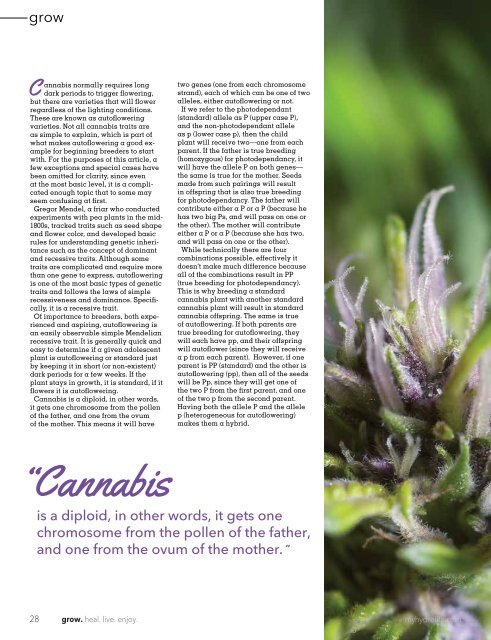Hydrolife Magazine October/November 2016 (USA Edition)
There is a lot of healing in this issue of Hydrolife. As medicinal marijuana gains acceptance in more jurisdictions, more stories are coming to the forefront revealing how cannabis healed a person where traditional drugs could not, or could but with severe side effects. We all want that miracle cure to be found where everybody is safe, where everybody is happy and where everybody is healthy.
There is a lot of healing in this issue of Hydrolife. As medicinal marijuana gains acceptance in more jurisdictions, more stories are coming to the forefront revealing how cannabis healed a person where traditional drugs could not, or could but with severe side effects. We all want that miracle cure to be found where everybody is safe, where everybody is happy and where everybody is healthy.
You also want an ePaper? Increase the reach of your titles
YUMPU automatically turns print PDFs into web optimized ePapers that Google loves.
grow<br />
Cannabis normally requires long<br />
dark periods to trigger flowering,<br />
but there are varieties that will flower<br />
regardless of the lighting conditions.<br />
These are known as autoflowering<br />
varieties. Not all cannabis traits are<br />
as simple to explain, which is part of<br />
what makes autoflowering a good example<br />
for beginning breeders to start<br />
with. For the purposes of this article, a<br />
few exceptions and special cases have<br />
been omitted for clarity, since even<br />
at the most basic level, it is a complicated<br />
enough topic that to some may<br />
seem confusing at first.<br />
Gregor Mendel, a friar who conducted<br />
experiments with pea plants in the mid-<br />
1800s, tracked traits such as seed shape<br />
and flower color, and developed basic<br />
rules for understanding genetic inheritance<br />
such as the concept of dominant<br />
and recessive traits. Although some<br />
traits are complicated and require more<br />
than one gene to express, autoflowering<br />
is one of the most basic types of genetic<br />
traits and follows the laws of simple<br />
recessiveness and dominance. Specifically,<br />
it is a recessive trait.<br />
Of importance to breeders, both experienced<br />
and aspiring, autoflowering is<br />
an easily observable simple Mendelian<br />
recessive trait. It is generally quick and<br />
easy to determine if a given adolescent<br />
plant is autoflowering or standard just<br />
by keeping it in short (or non-existent)<br />
dark periods for a few weeks. If the<br />
plant stays in growth, it is standard, if it<br />
flowers it is autoflowering.<br />
Cannabis is a diploid, in other words,<br />
it gets one chromosome from the pollen<br />
of the father, and one from the ovum<br />
of the mother. This means it will have<br />
two genes (one from each chromosome<br />
strand), each of which can be one of two<br />
alleles, either autoflowering or not.<br />
If we refer to the photodependant<br />
(standard) allele as P (upper case P),<br />
and the non-photodependant allele<br />
as p (lower case p), then the child<br />
plant will receive two—one from each<br />
parent. If the father is true breeding<br />
(homozygous) for photodependancy, it<br />
will have the allele P on both genes—<br />
the same is true for the mother. Seeds<br />
made from such pairings will result<br />
in offspring that is also true breeding<br />
for photodependancy. The father will<br />
contribute either a P or a P (because he<br />
has two big Ps, and will pass on one or<br />
the other). The mother will contribute<br />
either a P or a P (because she has two,<br />
and will pass on one or the other).<br />
While technically there are four<br />
combinations possible, effectively it<br />
doesn’t make much difference because<br />
all of the combinations result in PP<br />
(true breeding for photodependancy).<br />
This is why breeding a standard<br />
cannabis plant with another standard<br />
cannabis plant will result in standard<br />
cannabis offspring. The same is true<br />
of autoflowering. If both parents are<br />
true breeding for autoflowering, they<br />
will each have pp, and their offspring<br />
will autoflower (since they will receive<br />
a p from each parent). However, if one<br />
parent is PP (standard) and the other is<br />
autoflowering (pp), then all of the seeds<br />
will be Pp, since they will get one of<br />
the two P from the first parent, and one<br />
of the two p from the second parent.<br />
Having both the allele P and the allele<br />
p (heterogeneous for autoflowering)<br />
makes them a hybrid.<br />
“Cannabis<br />
is a diploid, in other words, it gets one<br />
chromosome from the pollen of the father,<br />
and one from the ovum of the mother.”<br />
28 grow. heal. live. enjoy.<br />
myhydrolife.com




![Hydrolife Magazine December 2017/January 2018 [CANADIAN EDITION]](https://img.yumpu.com/59790088/1/190x247/hydrolife-magazine-december-2017-january-2018-canadian-edition.jpg?quality=85)
![Hydrolife Magazine December 2017/January 2018 [USA EDITION]](https://img.yumpu.com/59790042/1/190x247/hydrolife-magazine-december-2017-january-2018-usa-edition.jpg?quality=85)
![Hydrolife Magazine October/November 2017 [Canada Edition]](https://img.yumpu.com/59493562/1/190x247/hydrolife-magazine-october-november-2017-canada-edition.jpg?quality=85)
![Hydrolife Magazine October/November 2017 [USA Edition]](https://img.yumpu.com/59493548/1/190x247/hydrolife-magazine-october-november-2017-usa-edition.jpg?quality=85)
![Hydrolife Magazine August/September 2017 [USA Edition]](https://img.yumpu.com/59236656/1/190x247/hydrolife-magazine-august-september-2017-usa-edition.jpg?quality=85)








